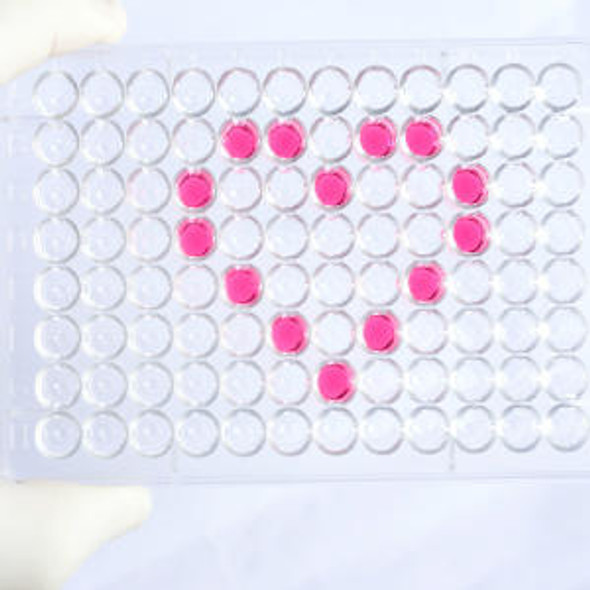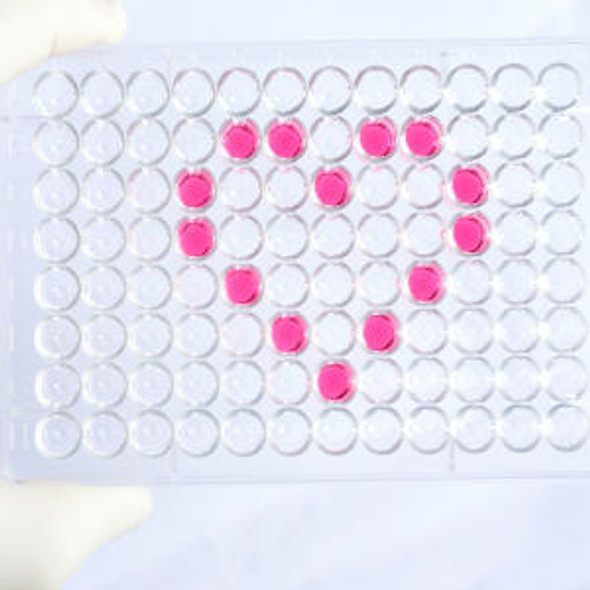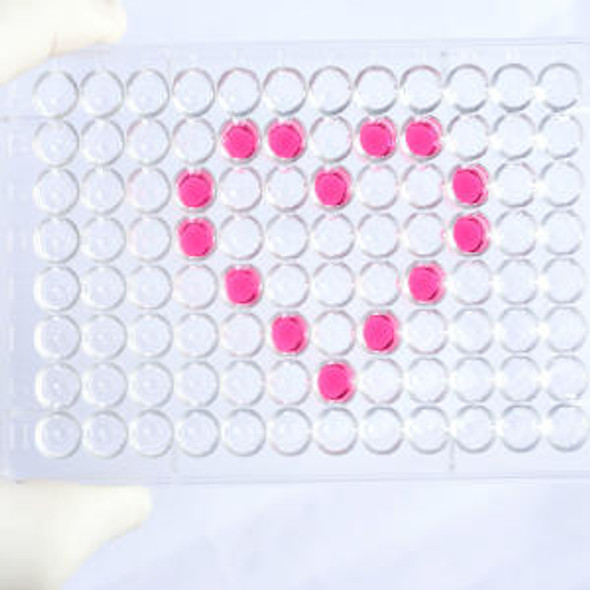Human Protein Wnt-7a (WNT7A) ELISA Kit
- SKU:
- HUEB2464
- Product Type:
- ELISA Kit
- Size:
- 96 Assays
- Uniprot:
- O00755
- Range:
- 31.2-2000 pg/mL
- ELISA Type:
- Sandwich
- Synonyms:
- WNT7A
- Reactivity:
- Human
Description
| Product Name: | Human Protein Wnt-7a (WNT7A) ELISA Kit |
| Product Code: | HUEB2464 |
| Alias: | Protein Wnt-7a, WNT7A |
| Uniprot: | O00755 |
| Reactivity: | Human |
| Range: | 31.2-2000 pg/mL |
| Detection Method: | Sandwich |
| Size: | 96 Assay |
| Storage: | Please see kit components below for exact storage details |
| Note: | For research use only |
| UniProt Protein Function: | WNT7A: Ligand for members of the frizzled family of seven transmembrane receptors. Probable developmental protein. Signaling by Wnt-7a allows sexually dimorphic development of the mullerian ducts. Defects in WNT7A are the cause of limb pelvis hypoplasia aplasia syndrome (LPHAS). A syndrome of severe deficiency of the extremities due to hypo- or aplasia of one or more long bones of one or more limbs. Pelvic manifestations include hip dislocation, hypoplastic iliac bone and aplastic pubic bones. Thoracic deformity, unusual facies and genitourinary anomalies can be present. Defects in WNT7A are a cause of Fuhrmann syndrome (FUHRS); also known as fibular aplasia or hypoplasia femoral bowing and poly- syn- and oligodactyly. Fuhrmann syndrome is a distinct limb-malformation disorder characterized also by various degrees of limb aplasia/hypoplasia and joint dysplasia. Belongs to the Wnt family. |
| UniProt Protein Details: | Protein type:Secreted; Secreted, signal peptide Chromosomal Location of Human Ortholog: 3p25 Cellular Component: proteinaceous extracellular matrix; extracellular space; cell surface; endoplasmic reticulum lumen; Golgi lumen; plasma membrane; extracellular region Molecular Function:frizzled binding; cytokine activity; receptor agonist activity; receptor binding Biological Process: embryonic forelimb morphogenesis; somatic stem cell maintenance; positive regulation of epithelial cell proliferation involved in wound healing; cell proliferation in forebrain; neurotransmitter secretion; positive regulation of transcription, DNA-dependent; positive regulation of JNK cascade; Wnt receptor signaling pathway through beta-catenin; palate development; embryonic hindlimb morphogenesis; response to estradiol stimulus; negative regulation of neurogenesis; neuron differentiation; central nervous system vasculogenesis; regulation of axon diameter; synapse organization and biogenesis; somatic stem cell division; chondrocyte differentiation; satellite cell activation; angiogenesis; fallopian tube development; cartilage condensation; cell fate commitment; embryonic axis specification; satellite cell compartment self-renewal involved in skeletal muscle regeneration; cerebellar granule cell differentiation; asymmetric protein localization; positive regulation of synaptogenesis; stem cell development; dorsal/ventral pattern formation; establishment of cell polarity; positive regulation of transcription from RNA polymerase II promoter; embryonic digit morphogenesis; sex differentiation; negative regulation of apoptosis Disease: Ulna And Fibula, Absence Of, With Severe Limb Deficiency; Fibular Aplasia Or Hypoplasia, Femoral Bowing And Poly-, Syn-, And Oligodactyly |
| NCBI Summary: | This gene is a member of the WNT gene family, which consists of structurally related genes that encode secreted signaling proteins. These proteins have been implicated in oncogenesis and in several developmental processes, including regulation of cell fate and patterning during embryogenesis. This gene is involved in the development of the anterior-posterior axis in the female reproductive tract, and also plays a critical role in uterine smooth muscle pattering and maintenance of adult uterine function. Mutations in this gene are associated with Fuhrmann and Al-Awadi/Raas-Rothschild/Schinzel phocomelia syndromes. [provided by RefSeq, Jul 2008] |
| UniProt Code: | O00755 |
| NCBI GenInfo Identifier: | 145559540 |
| NCBI Gene ID: | 7476 |
| NCBI Accession: | O00755.2 |
| UniProt Secondary Accession: | O00755,Q96H90, Q9Y560, |
| UniProt Related Accession: | O00755 |
| Molecular Weight: | 349 |
| NCBI Full Name: | Protein Wnt-7a |
| NCBI Synonym Full Names: | wingless-type MMTV integration site family, member 7A |
| NCBI Official Symbol: | WNT7A |
| NCBI Protein Information: | protein Wnt-7a; proto-oncogene Wnt7a protein |
| UniProt Protein Name: | Protein Wnt-7a |
| UniProt Gene Name: | WNT7A |
| UniProt Entry Name: | WNT7A_HUMAN |
| Component | Quantity (96 Assays) | Storage |
| ELISA Microplate (Dismountable) | 8×12 strips | -20°C |
| Lyophilized Standard | 2 | -20°C |
| Sample Diluent | 20ml | -20°C |
| Assay Diluent A | 10mL | -20°C |
| Assay Diluent B | 10mL | -20°C |
| Detection Reagent A | 120µL | -20°C |
| Detection Reagent B | 120µL | -20°C |
| Wash Buffer | 30mL | 4°C |
| Substrate | 10mL | 4°C |
| Stop Solution | 10mL | 4°C |
| Plate Sealer | 5 | - |
Other materials and equipment required:
- Microplate reader with 450 nm wavelength filter
- Multichannel Pipette, Pipette, microcentrifuge tubes and disposable pipette tips
- Incubator
- Deionized or distilled water
- Absorbent paper
- Buffer resevoir
*Note: The below protocol is a sample protocol. Protocols are specific to each batch/lot. For the correct instructions please follow the protocol included in your kit.
Allow all reagents to reach room temperature (Please do not dissolve the reagents at 37°C directly). All the reagents should be mixed thoroughly by gently swirling before pipetting. Avoid foaming. Keep appropriate numbers of strips for 1 experiment and remove extra strips from microtiter plate. Removed strips should be resealed and stored at -20°C until the kits expiry date. Prepare all reagents, working standards and samples as directed in the previous sections. Please predict the concentration before assaying. If values for these are not within the range of the standard curve, users must determine the optimal sample dilutions for their experiments. We recommend running all samples in duplicate.
| Step | |
| 1. | Add Sample: Add 100µL of Standard, Blank, or Sample per well. The blank well is added with Sample diluent. Solutions are added to the bottom of micro ELISA plate well, avoid inside wall touching and foaming as possible. Mix it gently. Cover the plate with sealer we provided. Incubate for 120 minutes at 37°C. |
| 2. | Remove the liquid from each well, don't wash. Add 100µL of Detection Reagent A working solution to each well. Cover with the Plate sealer. Gently tap the plate to ensure thorough mixing. Incubate for 1 hour at 37°C. Note: if Detection Reagent A appears cloudy warm to room temperature until solution is uniform. |
| 3. | Aspirate each well and wash, repeating the process three times. Wash by filling each well with Wash Buffer (approximately 400µL) (a squirt bottle, multi-channel pipette,manifold dispenser or automated washer are needed). Complete removal of liquid at each step is essential. After the last wash, completely remove remaining Wash Buffer by aspirating or decanting. Invert the plate and pat it against thick clean absorbent paper. |
| 4. | Add 100µL of Detection Reagent B working solution to each well. Cover with the Plate sealer. Incubate for 60 minutes at 37°C. |
| 5. | Repeat the wash process for five times as conducted in step 3. |
| 6. | Add 90µL of Substrate Solution to each well. Cover with a new Plate sealer and incubate for 10-20 minutes at 37°C. Protect the plate from light. The reaction time can be shortened or extended according to the actual color change, but this should not exceed more than 30 minutes. When apparent gradient appears in standard wells, user should terminatethe reaction. |
| 7. | Add 50µL of Stop Solution to each well. If color change does not appear uniform, gently tap the plate to ensure thorough mixing. |
| 8. | Determine the optical density (OD value) of each well at once, using a micro-plate reader set to 450 nm. User should open the micro-plate reader in advance, preheat the instrument, and set the testing parameters. |
| 9. | After experiment, store all reagents according to the specified storage temperature respectively until their expiry. |
When carrying out an ELISA assay it is important to prepare your samples in order to achieve the best possible results. Below we have a list of procedures for the preparation of samples for different sample types.
| Sample Type | Protocol |
| Serum | If using serum separator tubes, allow samples to clot for 30 minutes at room temperature. Centrifuge for 10 minutes at 1,000x g. Collect the serum fraction and assay promptly or aliquot and store the samples at -80°C. Avoid multiple freeze-thaw cycles. If serum separator tubes are not being used, allow samples to clot overnight at 2-8°C. Centrifuge for 10 minutes at 1,000x g. Remove serum and assay promptly or aliquot and store the samples at -80°C. Avoid multiple freeze-thaw cycles. |
| Plasma | Collect plasma using EDTA or heparin as an anticoagulant. Centrifuge samples at 4°C for 15 mins at 1000 × g within 30 mins of collection. Collect the plasma fraction and assay promptly or aliquot and store the samples at -80°C. Avoid multiple freeze-thaw cycles. Note: Over haemolysed samples are not suitable for use with this kit. |
| Urine & Cerebrospinal Fluid | Collect the urine (mid-stream) in a sterile container, centrifuge for 20 mins at 2000-3000 rpm. Remove supernatant and assay immediately. If any precipitation is detected, repeat the centrifugation step. A similar protocol can be used for cerebrospinal fluid. |
| Cell culture supernatant | Collect the cell culture media by pipette, followed by centrifugation at 4°C for 20 mins at 1500 rpm. Collect the clear supernatant and assay immediately. |
| Cell lysates | Solubilize cells in lysis buffer and allow to sit on ice for 30 minutes. Centrifuge tubes at 14,000 x g for 5 minutes to remove insoluble material. Aliquot the supernatant into a new tube and discard the remaining whole cell extract. Quantify total protein concentration using a total protein assay. Assay immediately or aliquot and store at ≤ -20 °C. |
| Tissue homogenates | The preparation of tissue homogenates will vary depending upon tissue type. Rinse tissue with 1X PBS to remove excess blood & homogenize in 20ml of 1X PBS (including protease inhibitors) and store overnight at ≤ -20°C. Two freeze-thaw cycles are required to break the cell membranes. To further disrupt the cell membranes you can sonicate the samples. Centrifuge homogenates for 5 mins at 5000xg. Remove the supernatant and assay immediately or aliquot and store at -20°C or -80°C. |
| Tissue lysates | Rinse tissue with PBS, cut into 1-2 mm pieces, and homogenize with a tissue homogenizer in PBS. Add an equal volume of RIPA buffer containing protease inhibitors and lyse tissues at room temperature for 30 minutes with gentle agitation. Centrifuge to remove debris. Quantify total protein concentration using a total protein assay. Assay immediately or aliquot and store at ≤ -20 °C. |
| Breast Milk | Collect milk samples and centrifuge at 10,000 x g for 60 min at 4°C. Aliquot the supernatant and assay. For long term use, store samples at -80°C. Minimize freeze/thaw cycles. |










